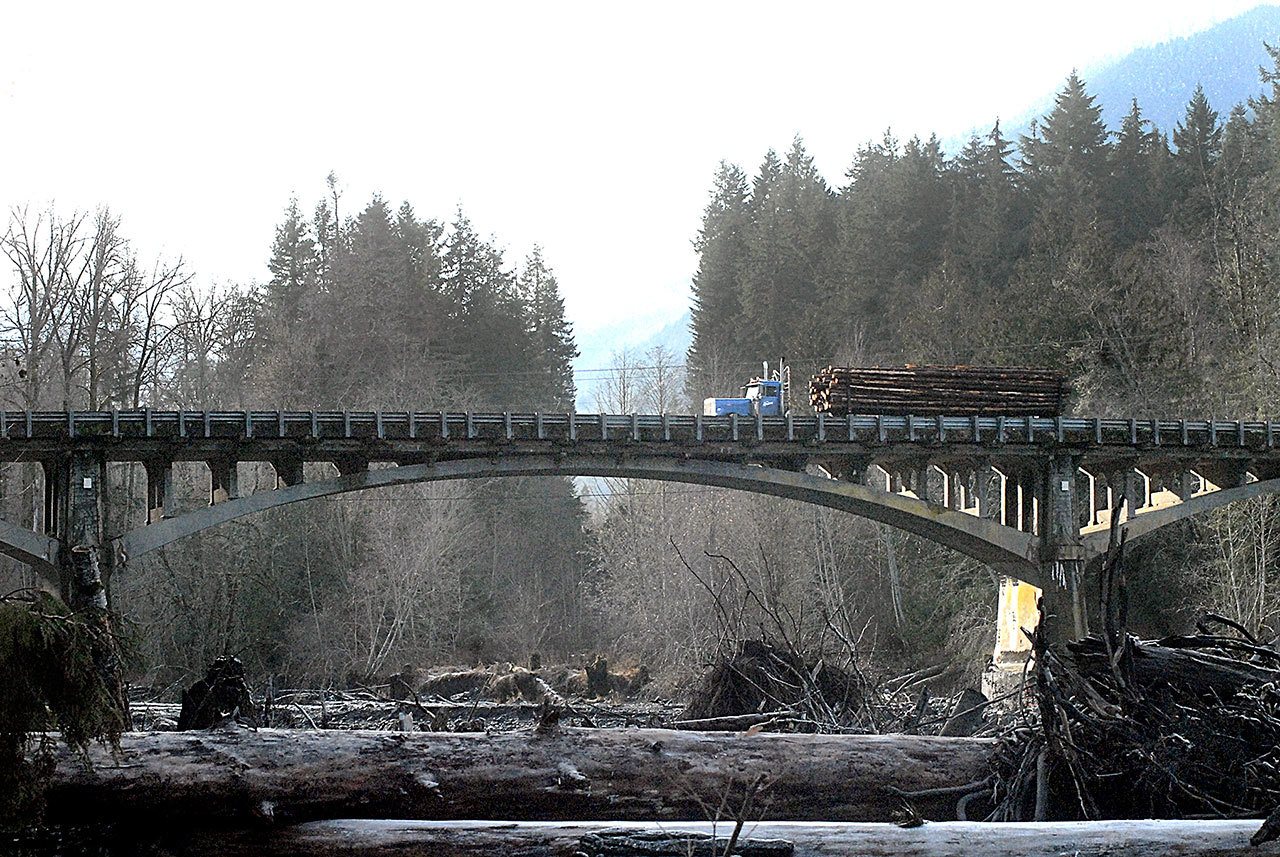PORT ANGELES — The Forks City Council has joined the chorus of those who are asking the state to replace the battered U.S. Highway 101 Elwha River bridge on a new alignment.
Council members voted 3-0 Tuesday to pass a resolution in support of a state Department of Transportation (DOT) design alternative — option 7 — that would place a new bridge north of the existing span with new approaches.
The 90-year-old concrete bridge’s piers are being undercut by the now free-flowing Elwha River.
Option 7 would allow drivers to use the existing bridge during construction, eliminating the need for lengthy detours onto state Highways 112 and 113.
It would also eliminate “dead man’s curve” east of the river where the highway meets Olympic Hot Springs Road, Forks Mayor Bryon Monohon said Wednesday.
“None of the other alternatives ensure the continued flow of commerce and travel while providing for a long-term, lasting solution to the current problem, as well as the bridge reaching the end of its useful life in a cost-efficient manner,” the resolution states.
Forks City Councilmen Ken Ayers, John Hillcar and Jon Preston approved the resolution during Tuesday night’s council meeting. Council members Bill Brager and Juanita Weissenfels were absent.
In a similar move, Clallam County Commissioners Mark Ozias and Bill Peach voted Dec. 13 to approve a letter cosigned by Sheriff Bill Benedict that urged the state to select option 7.
Former commissioner turned state Representative Mike Chapman abstained from that vote, saying he had to “keep an open mind” as a member of the House Transportation Committee.
Port of Port Angeles commissioners also have taken a public position in support of option 7 as the “most viable solution,” Commissioner Connie Beauvais has said.
State officials estimate that option 7 would cost between $18 million and $25 million and take one to two years to complete.
The Elwha River has scoured the bridge piers and riverbed since the removal of the Elwha Dam in 2012 and the Glines Canyon Dam in 2014.
The riverbed under the bridge has dropped about 14 feet since Lake Aldwell was drained in 2012, Transportation officials said.
Last fall, crews discovered that the bridge piers were built on gravel instead of bedrock. Cracks were found in the 388-foot-long structure.
The arch bridge is being closely monitored by Transportation engineers. It is safe to drive on as long as it is open, officials said.
Transportation received about 300 comments from citizens concerned about other design alternatives.
Option 7 was the “overwhelming preference” of citizens, Transportation spokeswoman Claudia Bingham Baker said in a Dec. 20 email.
In response to the public feedback, Transportation eliminated from further consideration three no-build options. A retrofit of the existing bridge was axed as a long-term solution.
“While I understand that the Department of Transportation had to put a wide range of possible solutions on the table, I was pleased to see that the less viable options have been set aside,” Beauvais said in a Dec. 22 email.
The Forks City Council said the no-build options would “seriously undermine the West End’s economic well-being and could lead to significant costs, design challenges and safety issues,” according to the resolution.
Here are the remaining design alternatives under consideration:
• 5. Existing alignment — Remove the existing bridge and replace it at the same location. Traffic would be detoured onto state Highway 112 during construction: $15 million to $20 million; two to three years.
• 6. Parallel alignment — Build a new bridge adjacent to the old bridge. The existing bridge would remain open during construction: $15 million to $20 million; one to two years.
• 7. New alignment — Build a new bridge north of the existing bridge. This would reduce the angle of the curve east of the bridge. The existing bridge would remain open during construction: $18 million to $25 million; one to two years.
Bingham Baker said there was no firm timeline for a decision. She added that Transportation was proceeding “aggressively.”
Given the required environmental permits, funding challenges and other hurdles, Bingham Baker warned that the bridge replacement could take “several years” to complete.
“It is definitely in the community’s best interest for WSDOT to do things right, and to do them right the first time,” Bingham Baker said in her email.
Monohon said the City Council added to the resolution a statement about “getting rid of the sharp corner, basically the dead man’s curve, and changing the slopes so that the whole thing was safer.”
“We’ve very much looking at reducing the safety and risk factors that have been associated with that corner for years,” Monohon said Wednesday.
A Transportation map of option 7, which is available at http://tinyurl.com/PDN-elwhariverbridge, shows a new bridge built to the north roughly 45-degrees to the existing bridge.
New approaches would result in a sweeping curve onto the bridge, which would have a 75-year lifespan.
Transportation officials presented the seven design alternatives in a special Forks City Council meeting Nov. 30. Monohon said Transportation’s presentations have been “well done and well received.”
West End citizens who testified at the November meeting urged the state to build a new bridge without detours and to do so quickly.
“I appreciate the expediency of DOT in moving this project through to a quick resolution and hope that a new bridge can be in place before total failure of the current one occurs,” Beauvais said.
_______
Reporter Rob Ollikainen can be reached at 360-452-2345, ext. 56450, or at rollikainen@peninsuladailynews.com.

